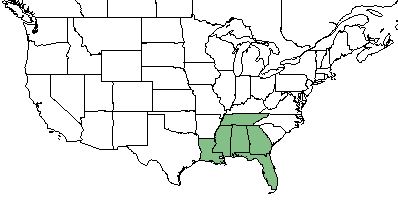Difference between revisions of "Gratiola floridana"
(→Ecology) |
(→Ecology) |
||
| Line 41: | Line 41: | ||
Species in the ''Gratiola'' genus were found in one study to appear in a community 13 years after a fire disturbance.<ref>Maliakal, S. K., et al. (2000). "Community composition and regeneration of Lake Wales Ridge wiregrass flatwoods in relation to time-since-fire " The Journal of the Torrey Botanical Society 127(2): 125-138.</ref> | Species in the ''Gratiola'' genus were found in one study to appear in a community 13 years after a fire disturbance.<ref>Maliakal, S. K., et al. (2000). "Community composition and regeneration of Lake Wales Ridge wiregrass flatwoods in relation to time-since-fire " The Journal of the Torrey Botanical Society 127(2): 125-138.</ref> | ||
<!--===Pollination===--> | <!--===Pollination===--> | ||
| − | + | ||
| + | ===Use by animals=== <!--Herbivory, granivory, insect hosting, etc.--> | ||
| + | Medicinally, species in the ''Gratiola'' genus are said to have purgative properties.<ref>Rafinesque, C. S. (1828). Medical flora; or Manual of the medical botany of the United States of North America.</ref> | ||
<!--==Diseases and parasites==--> | <!--==Diseases and parasites==--> | ||
Revision as of 14:40, 17 May 2019
Common name: Florida hedgehyssop
| Gratiola floridana | |
|---|---|

| |
| Photo by the Atlas of Florida Plants Database | |
| Scientific classification | |
| Kingdom: | Plantae |
| Division: | Magnoliophyta - Flowering plants |
| Class: | Magnoliopsida - Dicots |
| Order: | Scrophulariales |
| Family: | Scrophulariaceae |
| Genus: | Gratiola |
| Species: | G. floridana |
| Binomial name | |
| Gratiola floridana Nutt. | |

| |
| Natural range of Gratiola floridana from USDA NRCS Plants Database. | |
Contents
Taxonomic Notes
Description
Also known as the Florida hedgehyssop, G. floridana is a native annual forb that is a member of the Scrophulariaceae family.[1] Size class is between 0 to 1 foot with white to pink colored flowers.[2]
Distribution
G. floridana is found in the Southeast United States, ranging from Louisiana and Florida to less frequently found in Tennessee.[1] More specifically, it ranges from northeastern Georgia and southeastern Tennessee south to eastern Georgia, northeastern Florida and the panhandle, Alabama, and Mississippi.[3]
Ecology
Habitat
G. floridana can be found in spring runs, steam banks, and blackwater swamps [3]. It has specifically been seen in shaded wet muck of floodplains, and partially shaded mesic firebreak trails.[4] This species is also listed by the USDA Natural Resources Conservation Service as an obligate wetland species that only occurs in wetland habitats.[1]
Associated species - Ludwigia palustris [4]
Phenology
G. floridana has been observed to flower in March [5], but it has been seen to flower in April and May as well. Fruiting time ranges from March until April. [4]
Fire ecology
Species in the Gratiola genus were found in one study to appear in a community 13 years after a fire disturbance.[6]
Use by animals
Medicinally, species in the Gratiola genus are said to have purgative properties.[7]
Conservation and Management
It is considered endangered in the state of Tennessee yet not in any other region, but G. floridana should be monitored in the communities for its infrequency.[1] As well, it is listed on the global status as G4 due to its restricted distribution and rarity, and is vulnerable in Georgia, critically imperiled in Tennessee and Mississippi, and possibly extirpated in Louisiana.[8]
Cultivation and restoration
Photo Gallery
References and notes
- ↑ 1.0 1.1 1.2 1.3 USDA Plants Database URL: https://plants.usda.gov/core/profile?symbol=GRFL2
- ↑ [[1]] Lady Bird Johnson Wildflower Center. Accessed: May 17, 2019
- ↑ 3.0 3.1 Weakley, A. S. (2015). Flora of the Southern and Mid-Atlantic States. Chapel Hill, NC, University of North Carolina Herbarium.
- ↑ 4.0 4.1 4.2 Florida State University Robert K. Godfrey Herbarium database. URL: http://herbarium.bio.fsu.edu. Last accessed: June 2018. Collectors: Loran C. Anderson, David Roddenberry, Robert K. Godfrey, R. Kral, and J. M. Kane. States and counties: Florida: Gadsden, Wakulla, Jackson, and Leon. Georgia: Thomas. Alabama: Etowah, and Dallas.
- ↑ Nelson, G. PanFlora: Plant data for the eastern United States with emphasis on the Southeastern Coastal Plains, Florida, and the Florida Panhandle. www.gilnelson.com/PanFlora/ Accessed: 22 MAY 2018
- ↑ Maliakal, S. K., et al. (2000). "Community composition and regeneration of Lake Wales Ridge wiregrass flatwoods in relation to time-since-fire " The Journal of the Torrey Botanical Society 127(2): 125-138.
- ↑ Rafinesque, C. S. (1828). Medical flora; or Manual of the medical botany of the United States of North America.
- ↑ [[2]] NatureServe Explorer. Accessed: May 17, 2019